Exploring Anthocyanin and Free and Bound Phenolic Compounds from Two Morphotypes of Araçá (Psidium cattleianum Sabine) by LC-ESI-QqQ-MS/MS
Abstract
:1. Introduction
2. Materials and Methods
2.1. Chemicals and Reagents
2.2. Collection and Preparation of Samples
2.3. Extraction of Phenolic Compounds
2.3.1. Extraction of Phenolic Fractions
2.3.2. Free Phenolic Compounds
2.3.3. Esterified Phenolic Compounds
2.3.4. Glycosylated Phenolic Compounds
2.3.5. Insoluble Phenolic Compounds
2.4. Extraction of Anthocyanins
2.5. Quantification of Phenolic Compounds by LC-ESI-QqQ-MS/MS
2.6. Quantification of Anthocyanins by LC-ESI-QqQ-MS/MS
2.7. Methods Validation
2.8. Antioxidant Capacity by ORAC (Oxygen Radical Absorbance Capacity)
2.9. Statistical Analysis
3. Results and Discussion
3.1. Methods Validation
3.2. Quantification of Anthocyanins
3.3. Quantification of Phenolic Compounds
3.4. Antioxidant Capacity by Oxygen Radical Absorbance Capacity (ORAC)
3.5. Correlation between Phenolic Compounds and Antioxidant Capacity
3.6. Principal Component Analysis (PCA)
4. Conclusions
Author Contributions
Funding
Data Availability Statement
Acknowledgments
Conflicts of Interest
References
- da Silva, A.P.G.; Sganzerla, W.G.; Jacomino, A.P.; da Silva, E.P.; Xiao, J.; Simal-Gandara, J. Chemical Composition, Bioactive Compounds, and Perspectives for the Industrial Formulation of Health Products from Uvaia (Eugenia pyriformis Cambess—Myrtaceae): A Comprehensive Review. J. Food Compos. Anal. 2022, 109, 104500. [Google Scholar] [CrossRef]
- Sganzerla, W.G.; Komatsu, R.A.; Mangrich dos Passos, J.F.; Costa, M.D.; Dobler Stroschein, M.R.; Schons, P.F.; Paula de Lima Veeck, A. Variability in the Molecular, Phenological, and Physicochemical Characteristics of Uvaia (Eugenia pyriformis Cambess—Myrtaceae) Accessions from the Brazilian Atlantic Rainforest. Biocatal. Agric. Biotechnol. 2021, 35, 102082. [Google Scholar] [CrossRef]
- Dare, A.P.; Günther, C.S.; Grey, A.C.; Guo, G.; Demarais, N.J.; Cordiner, S.; McGhie, T.K.; Boldingh, H.; Hunt, M.; Deng, C.; et al. Resolving the Developmental Distribution Patterns of Polyphenols and Related Primary Metabolites in Bilberry (Vaccinium myrtillus) Fruit. Food Chem. 2022, 374, 131703. [Google Scholar] [CrossRef]
- Sik, B.; Ajtony, Z.; Lakatos, E.; Székelyhidi, R. The Effects of Extraction Conditions on the Antioxidant Activities, Total Polyphenol and Monomer Anthocyanin Contents of Six Edible Fruits Growing Wild in Hungary. Heliyon 2022, 8, e12048. [Google Scholar] [CrossRef]
- Donado-Pestana, C.M.; Moura, M.H.C.; de Araujo, R.L.; de Lima Santiago, G.; de Moraes Barros, H.R.; Genovese, M.I. Polyphenols from Brazilian Native Myrtaceae Fruits and Their Potential Health Benefits against Obesity and Its Associated Complications. Curr. Opin. Food Sci. 2018, 19, 42–49. [Google Scholar] [CrossRef]
- Teixeira, N.; Melo, J.C.S.; Batista, L.F.; Paula-Souza, J.; Fronza, P.; Brandão, M.G.L. Edible Fruits from Brazilian Biodiversity: A Review on Their Sensorial Characteristics versus Bioactivity as Tool to Select Research. Food Res. Int. 2019, 119, 325–348. [Google Scholar] [CrossRef]
- Ferreira Macedo, J.G.; Linhares Rangel, J.M.; de Oliveira Santos, M.; Camilo, C.J.; Martins da Costa, J.G.; de Almeida Souza, M.M. Therapeutic Indications, Chemical Composition and Biological Activity of Native Brazilian Species from Psidium genus (Myrtaceae): A Review. J. Ethnopharmacol. 2021, 278, 114248. [Google Scholar] [CrossRef]
- Dalla Nora, C.; Jablonski, A.; Rios, A.d.O.; Hertz, P.F.; de Jong, E.V.; Flôres, S.H. The Characterisation and Profile of the Bioactive Compounds in Red Guava (Psidium cattleyanum Sabine) and Guabiju (Myrcianthes pungens (O. Berg) D. Legrand). Int. J. Food Sci. Technol. 2014, 49, 1842–1849. [Google Scholar] [CrossRef]
- dos Santos Pereira, E.; Vinholes, J.; Franzon, R.C.; Dalmazo, G.; Vizzotto, M.; Nora, L. Psidium cattleianum Fruits: A Review on Its Composition and Bioactivity. Food Chem. 2018, 258, 95–103. [Google Scholar] [CrossRef]
- Beltrame, B.M.; Koetz, M.; Santos, M.C.; Soares, K.D.; de Loreto Bordignon, S.A.; Apel, M.A.; Klein-Júnior, L.C.; Schwanz, M.; Henriques, A.T. Two Morphotypes versus Two Chemotypes of Psidium cattleyanum: Chemical and Pharmacological Comparison and a Rational Approach for Marker Selection. J. Chromatogr. B Analyt Technol. Biomed. Life Sci. 2022, 1199, 123247. [Google Scholar] [CrossRef]
- dos Santos Pereira, E.; Vinholes, J.R.; Camargo, T.M.; Nora, F.R.; Crizel, R.L.; Chaves, F.; Nora, L.; Vizzotto, M. Characterization of Araçá Fruits (Psidium cattleianum Sabine): Phenolic Composition, Antioxidant Activity and Inhibition of α-Amylase and α-Glucosidase. Food Biosci. 2020, 37, 100665. [Google Scholar] [CrossRef]
- Medina, A.L.; Haas, L.I.R.; Chaves, F.C.; Salvador, M.; Zambiazi, R.C.; Da Silva, W.P.; Nora, L.; Rombaldi, C.V. Araçá (Psidium cattleianum Sabine) Fruit Extracts with Antioxidant and Antimicrobial Activities and Antiproliferative Effect on Human Cancer Cells. Food Chem. 2011, 128, 916–922. [Google Scholar] [CrossRef]
- Mallmann, L.P.; Tischer, B.; Vizzotto, M.; Rodrigues, E.; Manfroi, V. Comprehensive Identification and Quantification of Unexploited Phenolic Compounds from Red and Yellow Araçá (Psidium cattleianum Sabine) by LC-DAD-ESI-MS/MS. Food Res. Int. 2020, 131, 108978. [Google Scholar] [CrossRef]
- Arruda, H.S.; Pereira, G.A.; de Morais, D.R.; Eberlin, M.N.; Pastore, G.M. Determination of Free, Esterified, Glycosylated and Insoluble-Bound Phenolics Composition in the Edible Part of Araticum Fruit (Annona crassiflora Mart.) and Its by-Products by HPLC-ESI-MS/MS. Food Chem. 2018, 245, 738–749. [Google Scholar] [CrossRef]
- Farias, C.A.A.; Moraes, D.P.; Neuenfeldt, N.H.; Zabot, G.L.; Emanuelli, T.; Barin, J.S.; Ballus, C.A.; Barcia, M.T. Microwave Hydrodiffusion and Gravity Model with a Unique Hydration Strategy for Exhaustive Extraction of Anthocyanins from Strawberries and Raspberries. Food Chem. 2022, 383, 132446. [Google Scholar] [CrossRef]
- Machado, P.G.; Londero, D.S.; Farias, C.A.A.; Pudenzi, M.A.; Barcia, M.T.; Ballus, C.A. Guabijú (Myrcianthes pungens): A Comprehensive Evaluation of Anthocyanins and Free, Esterified, Glycosylated, and Insoluble Phenolic Compounds in Its Peel, Pulp, and Seeds. Food Chem. 2023, in press. [Google Scholar] [CrossRef]
- Thompson, M.; Ellison, S.L.R.; Wood, R. Resulting from the Symposium on Harmonization of Quality Assurance Systems for Analytical Laboratories. Pure Appl. Chem. 2002, 74, 835–855. [Google Scholar] [CrossRef]
- Ou, B.; Hampsch-Woodill, M.; Prior, R.L. Development and Validation of an Improved Oxygen Radical Absorbance Capacity Assay Using Fluorescein as the Fluorescent Probe. J. Agric. Food Chem. 2001, 49, 4619–4626. [Google Scholar] [CrossRef]
- Huang, D.; Ou, B.; Hampsch-Woodill, M.; Flanagan, J.A.; Prior, R.L. High-Throughput Assay of Oxygen Radical Absorbance Capacity (ORAC) Using a Multichannel Liquid Handling System Coupled with a Microplate Fluorescence Reader in 96-Well Format. J. Agric. Food Chem. 2002, 50, 4437–4444. [Google Scholar] [CrossRef]
- Dávalos, A.; Gómez-Cordovés, C.; Bartolomé, B. Extending Applicability of the Oxygen Radical Absorbance Capacity (ORAC-Fluorescein) Assay. J. Agric. Food Chem. 2004, 52, 48–54. [Google Scholar] [CrossRef]
- Sun, L.; Huo, J.; Liu, J.; Yu, J.; Zhou, J.; Sun, C.; Wang, Y.; Leng, F. Anthocyanins Distribution, Transcriptional Regulation, Epigenetic and Post-Translational Modification in Fruits. Food Chem. 2023, 411, 135540. [Google Scholar] [CrossRef] [PubMed]
- Qu, S.; Li, M.; Wang, G.; Yu, W.; Zhu, S. Transcriptomic, Proteomic and LC-MS Analyses Reveal Anthocyanin Biosynthesis during Litchi Pericarp Browning. Sci. Hortic. 2021, 289, 110443. [Google Scholar] [CrossRef]
- Liu, H.N.; Shu, Q.; Lin-Wang, K.; Espley, R.V.; Allan, A.C.; Pei, M.S.; Li, X.L.; Su, J.; Wu, J. DNA Methylation Reprogramming Provides Insights into Light-Induced Anthocyanin Biosynthesis in Red Pear. Plant Sci. 2023, 326, 111499. [Google Scholar] [CrossRef] [PubMed]
- Vinholes, J.; Lemos, G.; Lia Barbieri, R.; Franzon, R.C.; Vizzotto, M. In Vitro Assessment of the Antihyperglycemic and Antioxidant Properties of Araçá, Butiá and Pitanga. Food Biosci. 2017, 19, 92–100. [Google Scholar] [CrossRef]
- Cheng, Z.; Zhang, Z.; Han, Y.; Wang, J.; Wang, Y.; Chen, X.; Shao, Y.; Cheng, Y.; Zhou, W.; Lu, X.; et al. A Review on Anti-Cancer Effect of Green Tea Catechins. J. Funct. Foods 2020, 74, 104172. [Google Scholar]
- Gadkari, P.V.; Balaraman, M. Catechins: Sources, Extraction and Encapsulation: A Review. Food Bioprod. Process. 2015, 93, 122–138. [Google Scholar]
- Yilmazer-Musa, M.; Griffith, A.M.; Michels, A.J.; Schneider, E.; Frei, B. Grape Seed and Tea Extracts and Catechin 3-Gallates Are Potent Inhibitors of α-Amylase and α-Glucosidase Activity. J. Agric. Food Chem. 2012, 60, 8924–8929. [Google Scholar] [CrossRef]
- Al Zahrani, N.A.; El-Shishtawy, R.M.; Asiri, A.M. Recent Developments of Gallic Acid Derivatives and Their Hybrids in Medicinal Chemistry: A Review. Eur. J. Med. Chem. 2020, 204, 112609. [Google Scholar]
- Lone, S.H.; Rehman, S.U.; Bhat, K.A. Synthesis of Gallic-Acid-1-Phenyl-1H-[1,2,3]Triazol-4-Yl Methyl Esters as Effective Antioxidants. Drug Res. 2017, 11, 111–118. [Google Scholar] [CrossRef]
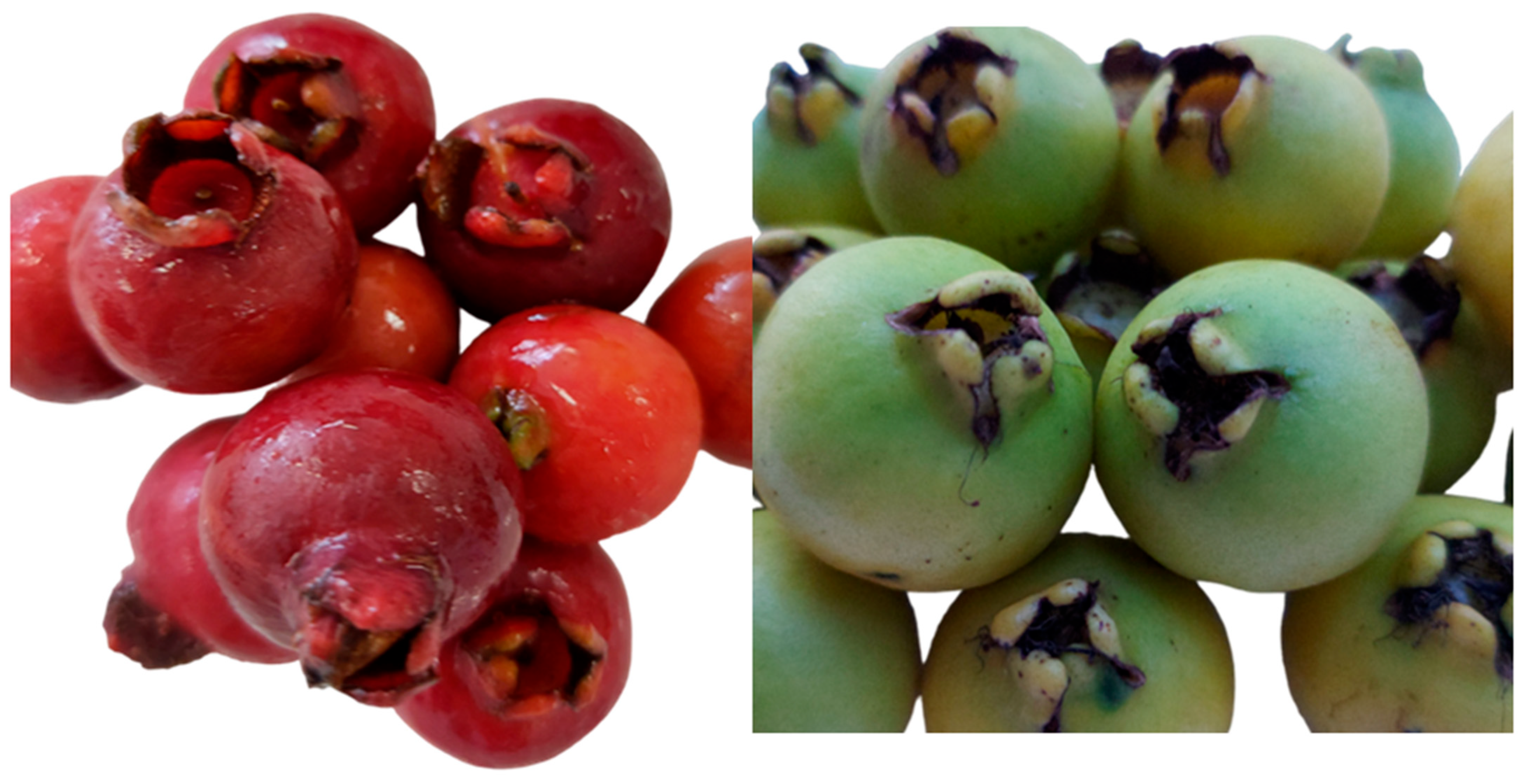
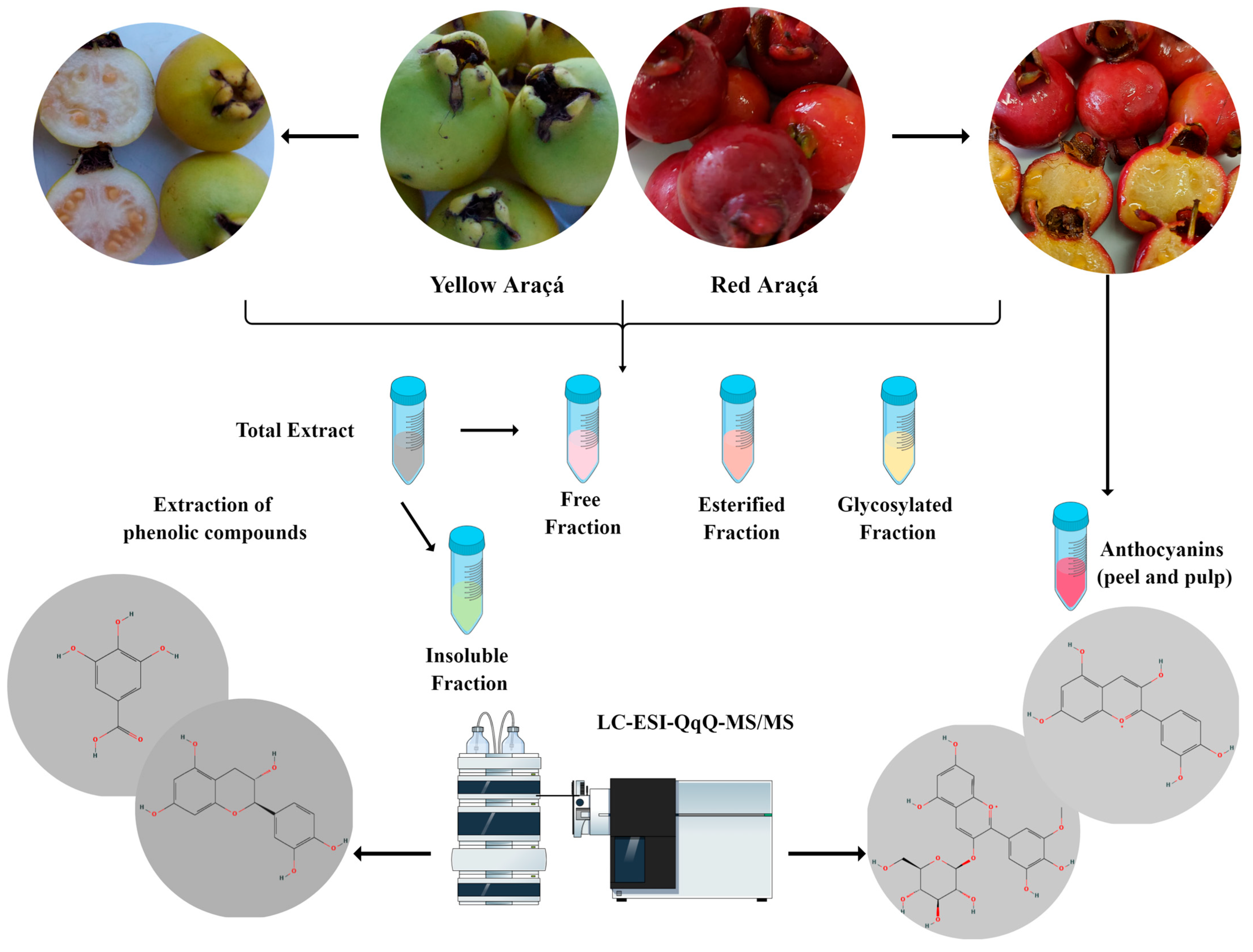
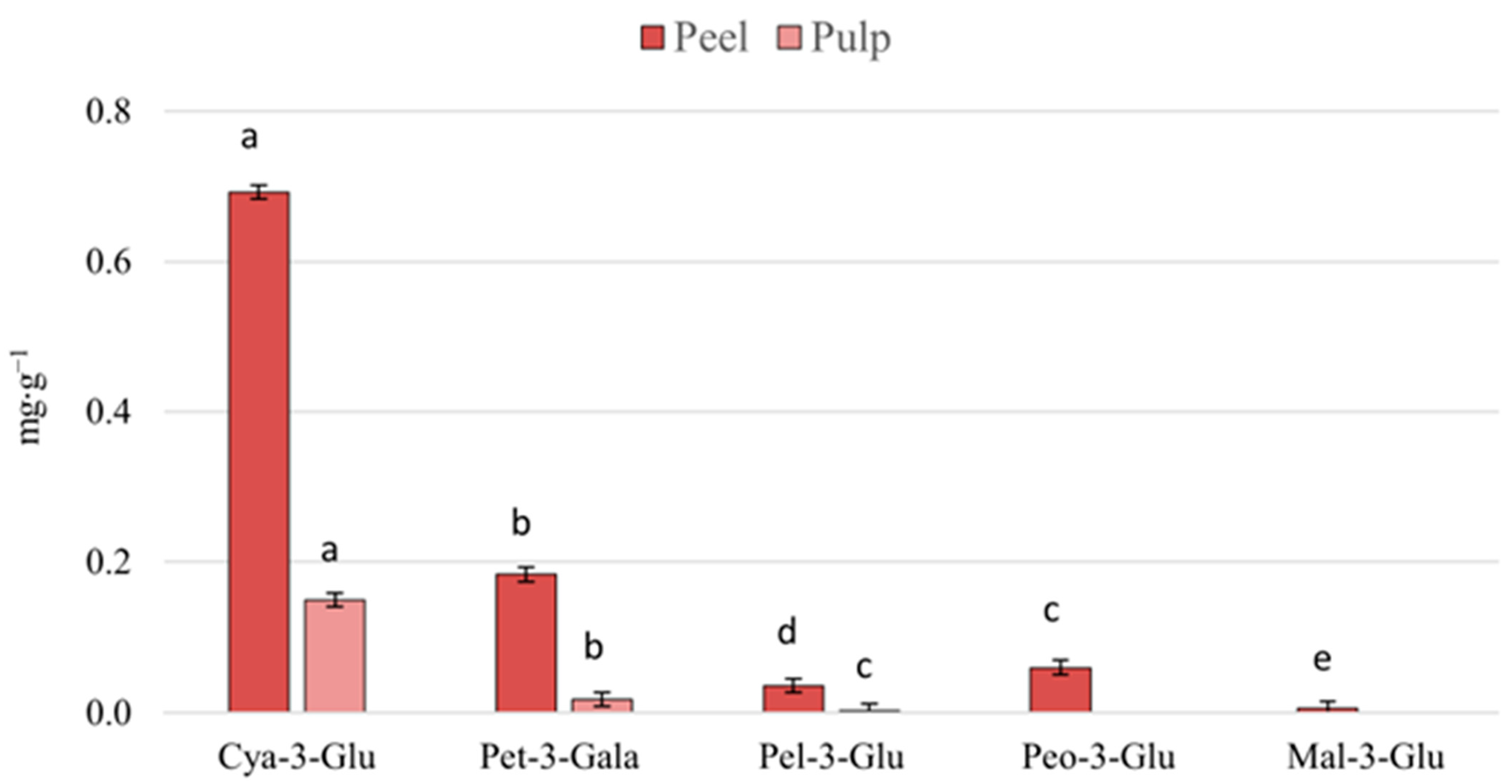
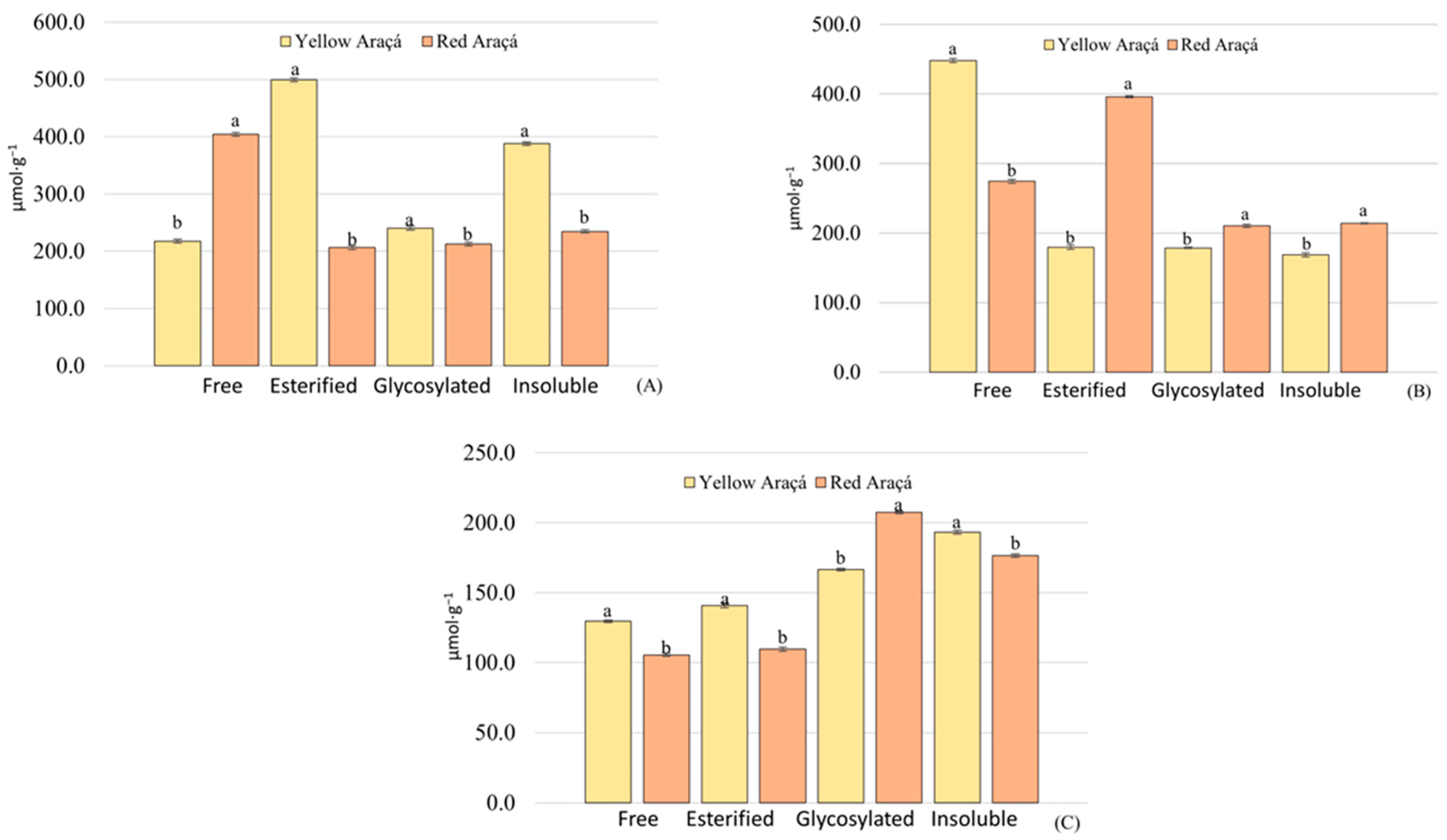
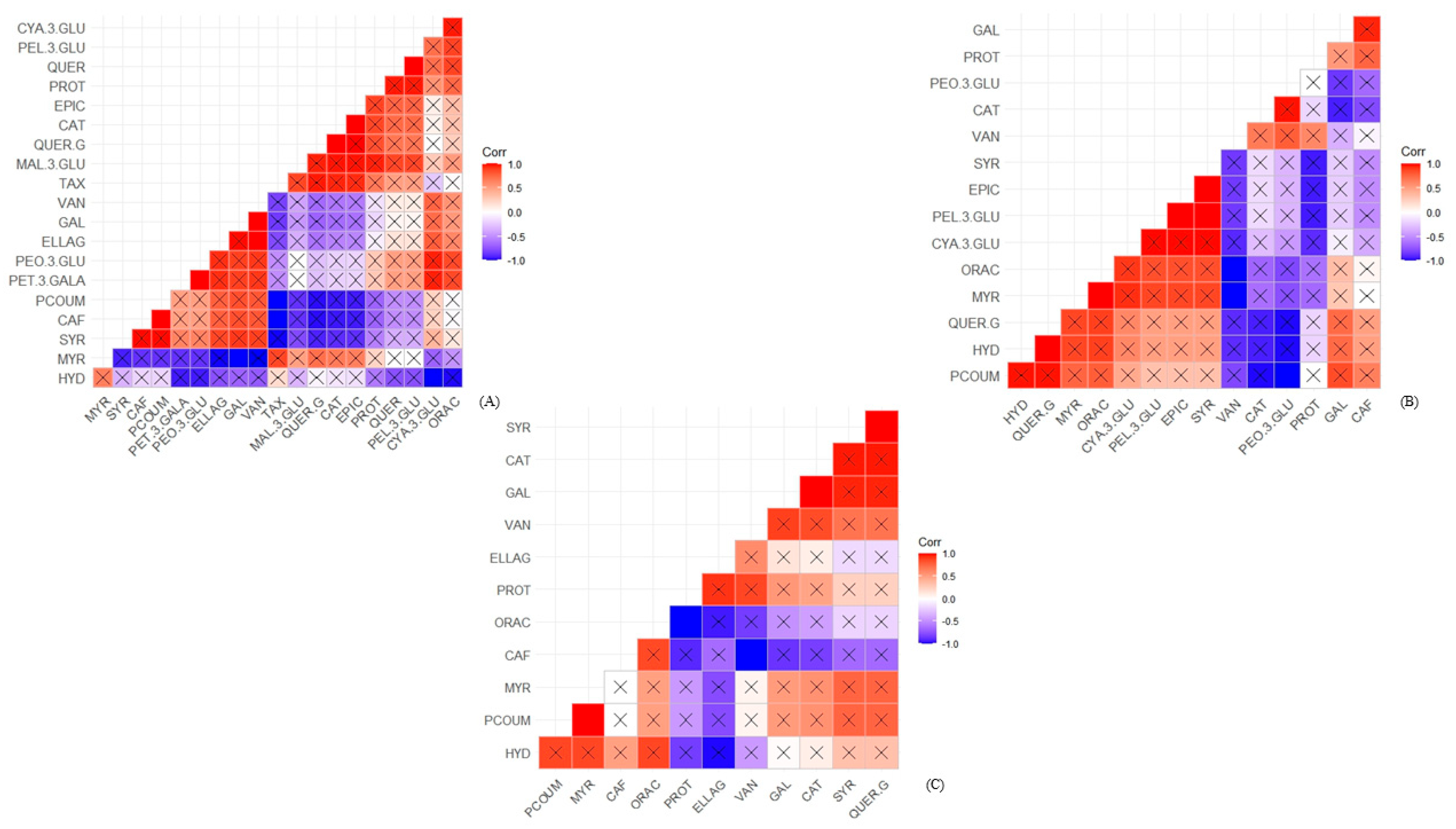
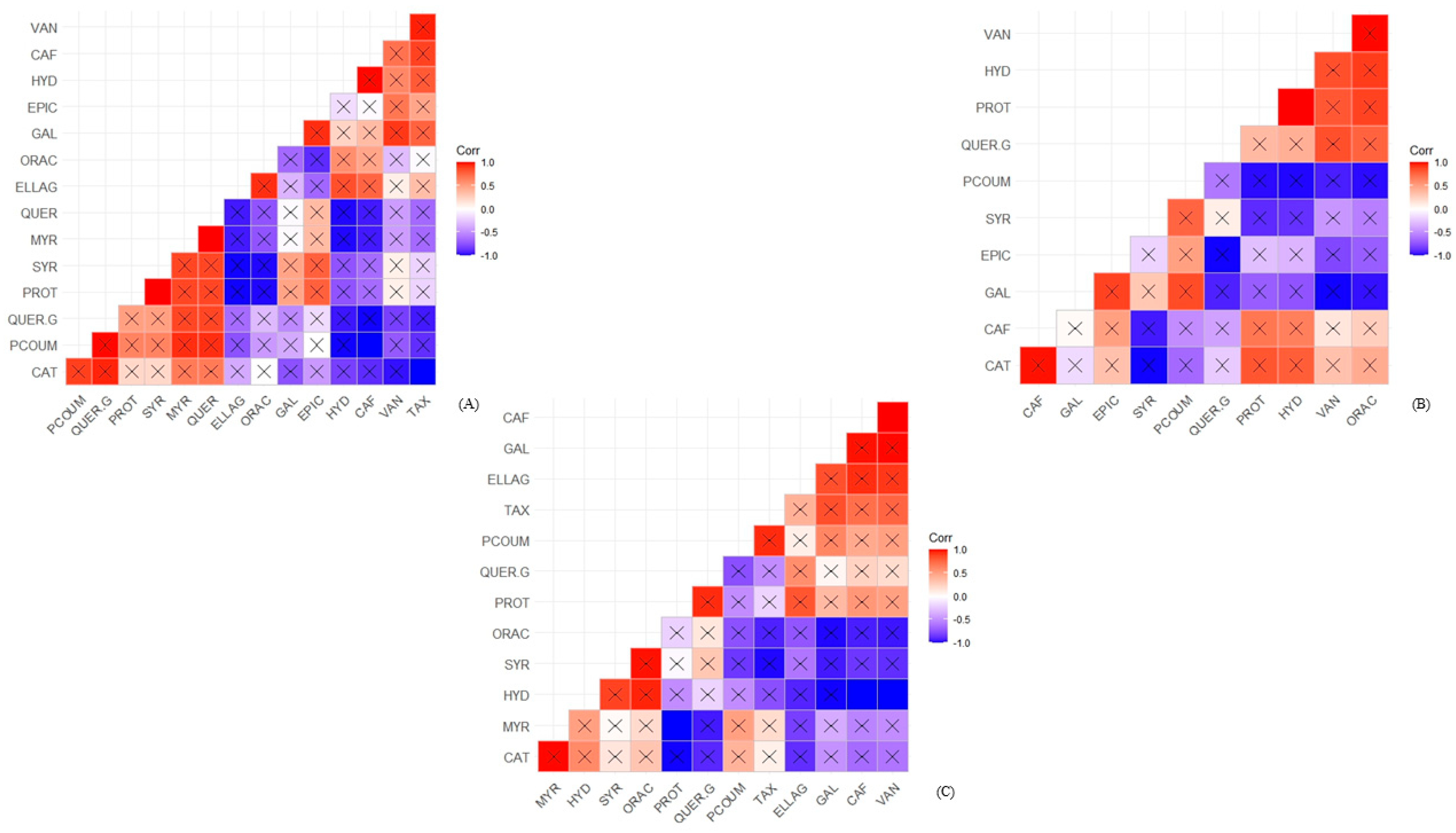
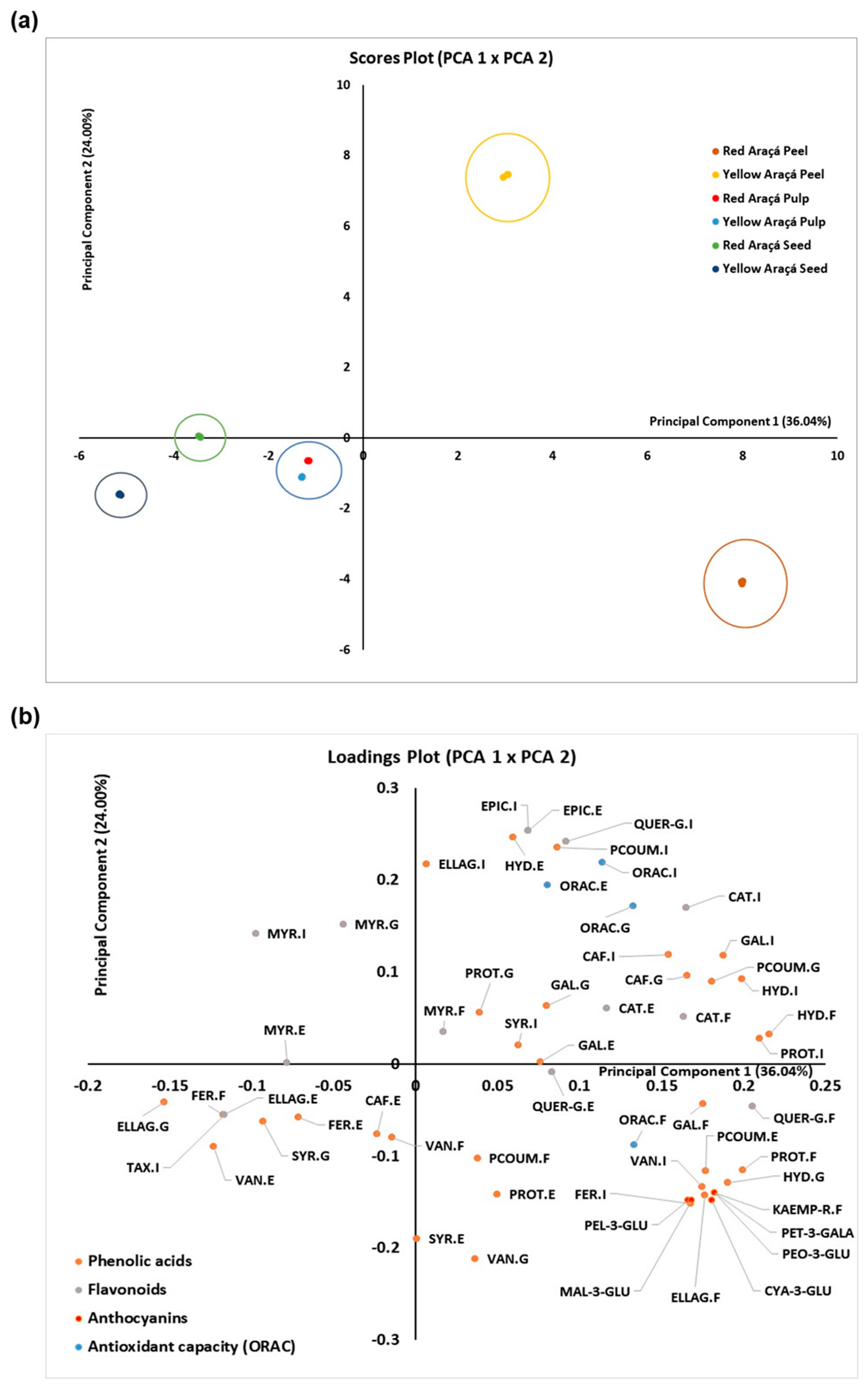
| Compounds | Transitions (m/z) | Retention Time (min) | Q1 (V) a | Q3 (V) a | CE (V) a | LOD a (mg L−1) | LOQ a (mg L−1) | r2 | Lack of Fit Test (p > 0.05) |
|---|---|---|---|---|---|---|---|---|---|
| Gallic acid | 169.20–125.10 * 169.20–78.90 ** | 6.92 | 14.0 14.0 | 23.0 15.0 | 16.0 22.0 | 0.0202 | 0.0061 | 0.9976 | 0.7231 |
| Protocatechuic acid | 153.10–109.05 153.10–108.00 | 9.65 | 13.0 13.0 | 12.0 19.0 | 15.0 23.0 | 0.0002 | 0.0006 | 0.9902 | 0.9218 |
| 4-Hydroxybenzoic acid | 137.20–93.00 137.20–65.05 | 12.34 | 29.0 29.0 | 16.0 24.0 | 16.0 30.0 | 0.0007 | 0.0023 | 0.9919 | 0.1188 |
| Chlorogenic acid | 353.10–191.20 353.10–84.90 | 12.07 | 17.0 29.0 | 21.0 14.0 | 17.0 46.0 | 0.0032 | 0.0053 | 0.9926 | 0.0871 |
| Catechin | 289.20–245.10 289.20–108.95 | 12.24 | 14.0 14.0 | 26.0 12.0 | 15.0 26.0 | 0.0014 | 0.0023 | 0.9934 | 0.0629 |
| Caffeic acid | 179.10–135.15 179.10–134.05 | 13.53 | 13.0 14.0 | 14.0 24.0 | 16.0 26.0 | 0.0011 | 0.0016 | 0.9920 | 0.0971 |
| Vanillic acid | 167.15–152.00 167.15–108.05 | 13.65 | 15.0 13.0 | 27.0 12.0 | 15.0 19.0 | 0.0013 | 0.0046 | 0.9983 | 0.0971 |
| Epicatechin | 289.10–245.15 289.10–109.00 | 13.74 | 15.0 13.0 | 18.0 21.0 | 14.0 23.0 | 0.0032 | 0.0019 | 0.9942 | 0.060 |
| Syringic acid | 197.00–182.15 197.00–123.05 | 14.07 | 18.0 14.0 | 19.0 24.0 | 14.0 24.0 | 0.0011 | 0.0013 | 0.9928 | 0.1474 |
| p-Coumaric acid | 163.10–119.10 163.10–93.05 | 16.24 | 15.0 15.0 | 13.0 18.0 | 15.0 32.0 | 0.0003 | 0.0017 | 0.9944 | 0.0905 |
| Ferulic acid | 193.00–134.05 193.00–178.15 | 18.57 | 14.0 14.0 | 14.0 19.0 | 17.0 14.0 | 0.0001 | 0.0002 | 0.9931 | 0.8921 |
| Ellagic Acid | 300.90–284.00 300.90–145.15 | 20.22 | 20.0 20.0 | 29.0 25.0 | 30.0 37.0 | 0.0007 | 0.0009 | 0.9928 | 0.2409 |
| Taxifolin | 303.10–285.15 303.10–125.05 | 20.55 | 14.0 15.0 | 21.0 13.0 | 12.0 21.0 | 0.0011 | 0.0036 | 0.9926 | 0.6177 |
| Quercetin-3-Glycoside | 463.20–300.00 463.20–301.10 | 21.14 | 17.0 13.0 | 30.0 20.0 | 27.0 23.0 | 0.0002 | 0.0005 | 0.9912 | 0.5951 |
| Myricetin | 317.10−151.10 | 24.30 | 15.0 | 28.0 | 24.0 | 0.00024 | 0.00062 | 0.9905 | 0.7309 |
| 317.10−179.10 | 15.0 | 19.0 | 20.0 | ||||||
| Pelargonidin-3-Glucoside | 432.90–271.00 432.90–121.00 | 17.83 | −11.0 −11.0 | −26.0 −18.0 | −22.0 −55.0 | 0.00013 | 0.00076 | 0.9922 | 0.1477 |
| Cyanidin-3-Glucoside | 448.90–286.95 448.90–137.00 | 15.36 | −15.0 −12.0 | −27.0 −20.0 | −24.0 −55.0 | 0.00022 | 0.000694 | 0.9919 | 0.1530 |
| Malvidin-3-Glucoside | 493.00–331.00 493.00–314.95 | 20.70 | −13.0 −10.0 | −20.0 −30.0 | −22.0 −50.0 | 0.0100 | 0.0390 | 0.9967 | 0.0746 |
| Delphinidin-3-Glucoside | 464.90–303.00 464.90–229.00 | 11.01 | −12.0 −12.0 | −29.0 −21.0 | −23.0 −55.0 | 0.0022 | 0.0067 | 0.9913 | 0.2792 |
| Peonidin-3-Glucoside | 463.00–301.00 463.00–286.05 | 19.46 | −16.0 −16.0 | −29.0 −27.0 | −21.0 −43.0 | 0.0122 | 0.0361 | 0.9949 | 0.2954 |
| Compounds | Araçá Samples | Peel (µg g−1) | Pulp (µg g−1) | Seed (µg g−1) | |||||||||
|---|---|---|---|---|---|---|---|---|---|---|---|---|---|
| F * | E * | G * | I * | F * | E * | G * | I * | F * | E * | G * | I * | ||
| Catechin | Red | 1040.4 a (±0.3) | 151.6 b (±0.07) | nq | 202.6 b (±0.5) | 158.7 b (±0.1) | 81.0 b (±0.1) | nq | 14.3 a (±0.1) | nq | 90.5 a (±0.1) | nq | nq |
| Yellow | 1034.6 a (±0.1) | 174.1 a (±0.5) | nq | 362.8 a (±0.3) | 1105.3 a (±0.7) | 235.2 a (±0.2) | nq | 12.6 b (±0.1) | 60.672 a (±0.1) | nq | nq | nq | |
| Epicatechin | Red | nq | nq | nq | nq | nq | nq | nq | nq | nq | nq | nq | nq |
| Yellow | nq | 9.6 a (±0.1) | nq | nq | nq | nq | nq | 2.6 a (±0.7) | nq | nq | nq | nq | |
| Myricetin | Red | 7.5 a (±0.1) | nq | nq | nq | nq | nq | 8.533 a (±0.4) | nq | 8.1 b (±0.1) | 8.4 a (±0.1) | nq | 9.4 a (±0.1) |
| Yellow | 7.5 a (±0.1) | nq | 9.6 a (±0.7) | 8.1 a (±0.1) | nq | nq | nq | nq | 9.2 a (±0.2) | nq | 8.2 a (±0.1) | 8.0 b (±0.2) | |
| Quercetin-3-Glycoside | Red | 31.0 a (±0.5) | 6.1 a (±0.1) | nq | 5.7 b (±0.1) | 10.6 b (±0.3) | nq | nq | nq | 8.2 a (±0.4) | 4.4 a (±0.5) | nq | nq |
| Yellow | 16.1 b (±0.5) | 4.9 b (±0.1) | nq | 49.1 a (±0.8) | 18.4 a (±0.2) | 4.9 a (±0.1) | nq | nq | nq | 4.5 a (±0.1) | nq | nq | |
| Taxifolin | Red | nq | nq | nq | nq | nq | nq | nq | nq | nq | nq | nq | nq |
| Yellow | nq | nq | nq | nq | nq | nq | nq | nq | nq | nq | nq | 7.3 a (±0.1) | |
| Gallic acid | Red | 173.5 a (±0.4) | 1260.5 a (±0.1) | 341.4 b (±0.3) | 919.7 a (±0.4) | 122.3 b (±0.3) | 1926.0 a (±0.8) | 668.6 a (±0.6) | 348.9 a (±0.2) | 35.5 b (±0.4) | 515.2 b (±0.4) | 78.7 b (±0.3) | 112.3 b (±0.2) |
| Yellow | 114.9 b (±0.2) | 1193.1 b (±0.7) | 441.9 a (±0.1) | 515.0 b (±0.3) | 151.5 a (±0.3) | 851.9 b (±0.2) | 144.1 b (±0.2) | 220.2 b (±0.6) | 41.8 a (±0.1) | 905.8 a (±0.2) | 183.7 a (±0.4) | 265.1 a (±0.1) | |
| Protocatechuic acid | Red | 4.3 a (±0.1) | 170.2 a (±0.3) | 6.4 a (±0.1) | 36.3 a (±0.2) | 1.5 a (±0.1) | 14.7 a (±0.2) | 7.0 a (±0.1) | 3.3 a (±0.2) | nq | 153.7 a (±0.6) | 11.2 a (±0.1) | 3.2 a (±0.1) |
| Yellow | 0.873 b (±0.1) | 14.7 b (±0.4) | 6.6 a (±0.1) | 25.3 b (±0.6) | 1.1 b (±0.2) | 9.2 b (±0.3) | 2.1 b (±0.5) | 2.5 b (±0.3) | nq | 88.2 b (±0.2) | 1.3 b (±0.2) | 3.2 a (±0.4) | |
| 4-Hydroxybenzoic acid | Red | 7.1 a (±0.2) | 3.4 b (±0.4) | 130.8 a (±0.1) | 113.6 a (±0.1) | 2.2 b (±0.3) | 2.5 b (±0.2) | 7.2 b (±0.2) | 2.6 a (±0.1) | nq | 5.5 a (±0.6) | nq | nq |
| Yellow | 5.4 b (±0.1) | 123.9 a (±0.4) | 12.1 b (±0.1) | 115.0 a (±0.1) | 3.1 a (±0.5) | 40.8 a (±0.3) | 9.7 a (±0.2) | nq | nq | 3.4 b (±0.2) | 4.8 a (±0.4) | nq | |
| Caffeic acid | Red | nq | 8.6 a (±0.1) | 4.3 b (±0.1) | 15.1 b (±0.2) | nq | 19.7 a (±0.2) | 4.3 a (±0.1) | nq | nq | 4.4 b (±0.3) | nq | nq |
| Yellow | nq | 6.3 b (±0.2) | 5.0 a (±0.6) | 115.0 a (±0.4) | nq | 12.9 b (±0.3) | nq | 16.1 a (±0.5) | nq | 9.2 a (±0.1) | nq | nq | |
| Vanillic acid | Red | 4.3 a (±0.1) | 11.1 a (±0.3) | 174.5 a (±0.1) | 125.2 a (±0.2) | nq | 122.2 a (±0.1) | 156.1 a (±0.2) | 4.1 a (±0.2) | 3.2 b (±0.5) | 4.8 b (±0.1) | 13.3 b (±0.6) | 23.4 a (±0.5) |
| Yellow | 2.8 b (±0.1) | 7.3 b (±0.1) | 10.9 b (±0.2) | 11.9 b (±0.3) | 5.4 a (±0.6) | 121.1 a (±0.3) | 128.5 b (±0.7) | 3.7 b (±0.1) | 5.4 a (±0.3) | 120.6 a (±0.2) | 146.4 a (±0.4) | 12.5 b (±0.7) | |
| Syringic acid | Red | nq | 87.4 a (±0.1) | 18.2 a (±0.3) | 6.0 b (±0.1) | nq | 101.4 a (±0.6) | 13.1 a (±0.1) | nq | nq | 6.9 b (±0.1) | 3.7 b (±0.1) | 6.4 a (±0.2) |
| Yellow | nq | 9.7 b (±0.4) | 12.3 b (±0.4) | 4.7 a (±0.1) | nq | 96.4 b (±0.2) | 8.9 b (±0.7) | nq | nq | 89.9 a (±0.1) | 95.2 a (±0.2) | 4.1 b (±0.4) | |
| p-Coumaric acid | Red | 8.2 a (±0.2) | 26.9 a (±0.8) | 3.5 b (±0.8) | 5.0 b (±0.3) | nq | 8.0 a (±0.1) | nq | nq | nq | 9.0 a (±0.3) | nq | 2.0 b (±0.1) |
| Yellow | 2.6 b (±0.7) | 8.3 b (±0.2) | 3.9 a (±0.1) | 26.7 a (±0.5) | 1.4 a (±0.1) | 3.1 b (±0.4) | 2.6 a (±0.2) | nq | 10.5 a (±0.1) | 7.3 b (±0.7) | nq | 3.6 a (±0.5) | |
| Ferulic acid | Red | nq | nq | nq | 22.6 b (±0.2) | nq | nq | nq | nq | nq | nq | nq | nq |
| Yellow | nq | nq | nq | 27.2 a (±0.3) | nq | 5.1 a (±0.1) | nq | nq | 15.0 a (±0.2) | 1.9 a (±0.5) | nq | 3.2 a (±0.2) | |
| Ellagic Acid | Red | 8497.2 a (±0.3) | nq | nq | nq | nq | nq | nq | nq | 987.1 a (±0.2) | nq | 8114.0 a (±0.2) | nq |
| Yellow | nq | nq | nq | 793.1 a (±0.1) | nq | nq | nq | nq | nq | 949.9 a (±0.5) | 7565.9 b (±0.1) | 420.1 a (±0.2) | |
Disclaimer/Publisher’s Note: The statements, opinions and data contained in all publications are solely those of the individual author(s) and contributor(s) and not of MDPI and/or the editor(s). MDPI and/or the editor(s) disclaim responsibility for any injury to people or property resulting from any ideas, methods, instructions or products referred to in the content. |
© 2023 by the authors. Licensee MDPI, Basel, Switzerland. This article is an open access article distributed under the terms and conditions of the Creative Commons Attribution (CC BY) license (https://creativecommons.org/licenses/by/4.0/).
Share and Cite
Machado, P.G.; Londero, D.S.; Barcia, M.T.; Ballus, C.A. Exploring Anthocyanin and Free and Bound Phenolic Compounds from Two Morphotypes of Araçá (Psidium cattleianum Sabine) by LC-ESI-QqQ-MS/MS. Foods 2023, 12, 3230. https://doi.org/10.3390/foods12173230
Machado PG, Londero DS, Barcia MT, Ballus CA. Exploring Anthocyanin and Free and Bound Phenolic Compounds from Two Morphotypes of Araçá (Psidium cattleianum Sabine) by LC-ESI-QqQ-MS/MS. Foods. 2023; 12(17):3230. https://doi.org/10.3390/foods12173230
Chicago/Turabian StyleMachado, Patrícia Gotardo, Danielle Santos Londero, Milene Teixeira Barcia, and Cristiano Augusto Ballus. 2023. "Exploring Anthocyanin and Free and Bound Phenolic Compounds from Two Morphotypes of Araçá (Psidium cattleianum Sabine) by LC-ESI-QqQ-MS/MS" Foods 12, no. 17: 3230. https://doi.org/10.3390/foods12173230
APA StyleMachado, P. G., Londero, D. S., Barcia, M. T., & Ballus, C. A. (2023). Exploring Anthocyanin and Free and Bound Phenolic Compounds from Two Morphotypes of Araçá (Psidium cattleianum Sabine) by LC-ESI-QqQ-MS/MS. Foods, 12(17), 3230. https://doi.org/10.3390/foods12173230









